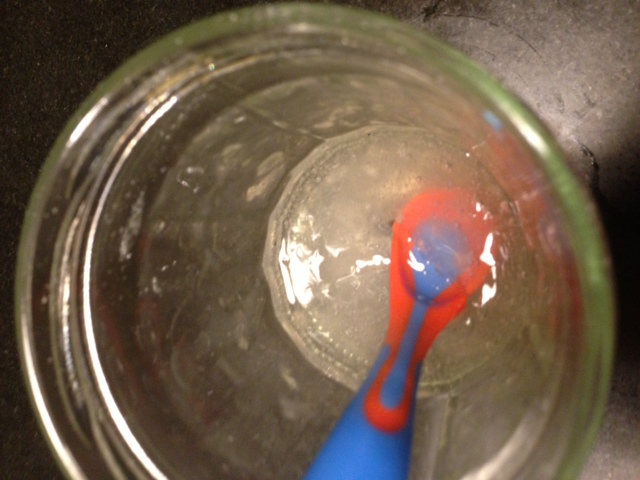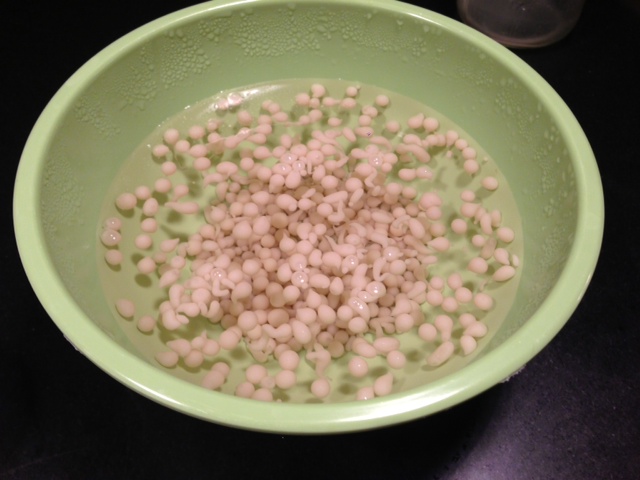Yeast immobilization is the weirdest brewing technology I've ever stumbled upon. The idea is to suspend living yeast cells in a semi-permeable solid, producing "beads" with the mystical ability to turn wort into beer. The advantages are obvious: if you start with a few hundred macroscopic spheres rather than a few hundred billion microscopic cells, separating your yeast from your beer becomes very simple. No fermentor goop, no clearing time, no sludge in your finished beer. When you're done, just scoop the beads out, rinse them off, and chuck them in the fridge till next time.
The downsides are also obvious, or at least they seem to be. Immobilized yeast don't actually reproduce. The conventional wisdom would suggest that this should have a significant impact on beer flavor, particularly in yeast-driven styles. Frankly, my hunch is that this is true, and I mostly expect that this experiment will produce sub-par beer. In other words, I anticipate that this will be my one and only attempt at yeast immobilization. But, it's a neat idea, so I thought I'd give it a go.
There are many different viable approaches here, but I'm using sodium alginate. Sodium alginate is an edible salt derived from seaweed. It produces a gooey slime when mixed with water, but that slime turns into a rubbery solid in the presence of calcium. The process is simple and the materials are cheap. Below is the recipe for 100 billion immobilized cells. Scale appropriately to your needs:
Ingredients
* 75 mL of slurry containing 100 billion healthy yeast cells.
* 75 mL of 4% sodium alginate solution (3g sodium alginate)
* 500mL of 1.5% calcium chloride solution (7.5g calcium chloride)
* distilled water (truth be told, I just used tap water and it worked fine, but if your tap water has high mineral content you might consider distilled.)
All of this stuff is cheap. Most people treating their water should already have calcium chloride, and most homebrew shops will sell you more than you ever need for a few bucks. Sodium alginate is a bit more expensive, but $15 of it will last you until the end of time. Amazon sells it in fancy packages for use in "molecular gastronomy" (which is what happens when you let nerds cook).
Steps (see pictures below):
1) Mix the sodium alginate solution well; this takes work. It should be homogenous and similar in appearance to the ectoplasm from Ghostbusters when you're done.
2) Stir in the yeast slurry and homogenize once again.
3) Using a syringe or pipet, drip the horrible goop you have created into your calcium chloride solution, one drop at a time.
4) Let stand for 10-15 minutes to make sure the beads have time to solidify all the way through, then strain them out! Easy as strudel.



-----------------------------
I can confirm that the magic yeast beans work, but I can't yet comment on how the beer tastes. I brewed up two small batches and am currently fermenting them side-by-side. I'll post results as I get them in the next post.
FAQ
Q: Do you know what that stuff looks like?
A: Yes, I know what that stuff looks like.
The downsides are also obvious, or at least they seem to be. Immobilized yeast don't actually reproduce. The conventional wisdom would suggest that this should have a significant impact on beer flavor, particularly in yeast-driven styles. Frankly, my hunch is that this is true, and I mostly expect that this experiment will produce sub-par beer. In other words, I anticipate that this will be my one and only attempt at yeast immobilization. But, it's a neat idea, so I thought I'd give it a go.
There are many different viable approaches here, but I'm using sodium alginate. Sodium alginate is an edible salt derived from seaweed. It produces a gooey slime when mixed with water, but that slime turns into a rubbery solid in the presence of calcium. The process is simple and the materials are cheap. Below is the recipe for 100 billion immobilized cells. Scale appropriately to your needs:
Ingredients
* 75 mL of slurry containing 100 billion healthy yeast cells.
* 75 mL of 4% sodium alginate solution (3g sodium alginate)
* 500mL of 1.5% calcium chloride solution (7.5g calcium chloride)
* distilled water (truth be told, I just used tap water and it worked fine, but if your tap water has high mineral content you might consider distilled.)
All of this stuff is cheap. Most people treating their water should already have calcium chloride, and most homebrew shops will sell you more than you ever need for a few bucks. Sodium alginate is a bit more expensive, but $15 of it will last you until the end of time. Amazon sells it in fancy packages for use in "molecular gastronomy" (which is what happens when you let nerds cook).
Steps (see pictures below):
1) Mix the sodium alginate solution well; this takes work. It should be homogenous and similar in appearance to the ectoplasm from Ghostbusters when you're done.
2) Stir in the yeast slurry and homogenize once again.
3) Using a syringe or pipet, drip the horrible goop you have created into your calcium chloride solution, one drop at a time.
4) Let stand for 10-15 minutes to make sure the beads have time to solidify all the way through, then strain them out! Easy as strudel.



-----------------------------
I can confirm that the magic yeast beans work, but I can't yet comment on how the beer tastes. I brewed up two small batches and am currently fermenting them side-by-side. I'll post results as I get them in the next post.
FAQ
Q: Do you know what that stuff looks like?
A: Yes, I know what that stuff looks like.
Last edited by a moderator:







